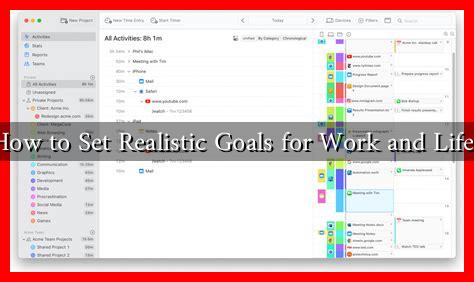-
Table of Contents
How to Set Realistic Goals for Work and Life
Setting realistic goals is a crucial aspect of achieving success in both personal and professional realms. Goals provide direction, motivation, and a sense of purpose. However, the key to effective goal-setting lies in ensuring that these goals are realistic and attainable. This article will explore strategies for setting realistic goals, supported by examples, case studies, and relevant statistics.
The Importance of Realistic Goals
Realistic goals are essential for several reasons:
- Motivation: Achievable goals keep you motivated and focused.
- Clarity: They provide a clear roadmap for what you want to accomplish.
- Confidence: Successfully reaching smaller, realistic goals builds confidence for tackling larger challenges.
- Time Management: Realistic goals help in prioritizing tasks effectively.
According to a study by the Dominican University of California, individuals who set specific goals are 42% more likely to achieve them compared to those who do not. This statistic underscores the importance of not just setting goals, but setting the right kind of goals.
Strategies for Setting Realistic Goals
To set realistic goals, consider the following strategies:
1. Use the SMART Criteria
The SMART framework is a widely recognized method for goal-setting. SMART stands for:
- Specific: Clearly define what you want to achieve.
- Measurable: Establish criteria to measure your progress.
- Achievable: Ensure that your goal is attainable given your resources and constraints.
- Relevant: Align your goal with your broader life objectives.
- Time-bound: Set a deadline for achieving your goal.
For example, instead of saying, “I want to get fit,” a SMART goal would be, “I will exercise for 30 minutes, five times a week for the next three months.”
2. Break Goals into Smaller Steps
Large goals can be overwhelming. Breaking them down into smaller, manageable steps can make them more achievable. For instance:
- Goal: Write a book.
- Smaller Steps:
- Outline the chapters.
- Write 500 words a day.
- Edit one chapter per week.
This approach not only makes the goal less daunting but also allows for regular progress checks.
3. Set Priorities
Not all goals are created equal. Prioritizing your goals helps you focus on what matters most. Consider using the Eisenhower Matrix to categorize your goals into four quadrants:
- Urgent and Important: Do these tasks immediately.
- Important but Not Urgent: Schedule these tasks.
- Urgent but Not Important: Delegate these tasks.
- Neither Urgent nor Important: Eliminate these tasks.
This method can help you allocate your time and energy more effectively.
4. Regularly Review and Adjust Goals
Life is dynamic, and so are your circumstances. Regularly reviewing your goals allows you to adjust them as needed. Set aside time each month to assess your progress and make necessary changes. This practice not only keeps you on track but also helps you stay motivated.
Case Study: The Power of Realistic Goal-Setting
A notable example of effective goal-setting is the story of J.K. Rowling, the author of the Harry Potter series. Before her success, Rowling faced numerous rejections from publishers. Instead of giving up, she set realistic goals for herself, such as writing a certain number of pages each day. Her persistence and structured approach eventually led to the publication of one of the best-selling book series in history.
Conclusion
Setting realistic goals is a vital skill that can significantly impact your success in both work and life. By utilizing the SMART criteria, breaking goals into smaller steps, prioritizing effectively, and regularly reviewing your progress, you can create a roadmap that leads to achievement and fulfillment. Remember, the journey of a thousand miles begins with a single step—make sure that step is realistic and attainable.
For more insights on effective goal-setting, consider visiting MindTools, which offers a wealth of resources on personal and professional development.

